The Great Escape (Almost)
by Marc L. Hamel in collaboration with Maj. Gen. Luther H. Richmond (USAF
Ret.)
“In July of 1944, two of my roommates and myself were asked to
join in a tunnel digging project. It seems that the Germans had been seen
digging up a seismic type sensor at the fence-line outside of Barracks 6,
West Compound and hauling it off for repair. Such sensors were buried all
along the perimeter fences and wired into the German “Abwehr” or
Security Office in the Vorlager. Thus the Germans were aware of tunnel
attempts almost as soon as they were begun. They would then find them at
will with their long steel probes. Their procedure was to let a tunnel
proceed to near-completion, and then “find” it and collapse it with a
fire hose and water. This missing sensor gave the Germans a blind spot,
and a tunnel in that area might just prove successful. For that reason, we
three roommates decided to join in the dig and promptly thought up some
appropriate nicknames for ourselves; “Mole” McKenzie, “Weasel”
Wangeman, and “Ratsy” Richmond.
There were 27 of us on this project, and we decided to innovate and
devise new tunneling techniques in the interest of speed and efficiency.
We were of course anxious to complete the job before the Germans could get
the sensor repaired and back in place. In our area of the Baltic Sea
coast, the soil was all sand with the water table a little over six feet
down. Therefore, our tunnels (unlike the fancy ones you have seen in the
movies) were about 2 feet in diameter with no bracing or shoring of any
kind. We crawled through them using our elbows and toes, and it wasn’t
hard at all to become quite claustrophobic; in fact it was quite
easy. Our security for this job was outstanding. None of the 27 tunnelers
lived in Barracks 6, and we wanted to keep our activities from all other
“Kriegies” (prisoners) as well as the Germans. Our first task was to
dig a “well” under the end room closest to the perimeter fence. There
were 3 or 4 dog runs under the barracks so the German police dogs could
run through at night to see if anything suspicious was going on. Our plan
was to use the closest run to gain access under this end room. With three
of four of our own sentries lolling about, several men would enter the dog
run. The sides were banked right up to the barracks floor, so about midway
through the run, we would remove a portion of the banking and dig out a
crawl space to get under the end room. The man remaining in the run would
repair the banking and leave. Using this method, the well was completed in
about a week, fitted with a wooden cover, and covered over with sand
against any snooping Germans.
 |
| Guard with flashlight in newly
discovered tunnel at Stalag Luft I |
|
At the bottom of the well, a bellows type air pump (made from a British
barracks bag) was installed. This would be used to pump air to the tunnel
digger via a nested tin can pipeline buried along one side of the tunnel
floor. One man was our head digger, and once the well was finished, he
proceeded towards the fence line with his Kreigie lamp and small compass.
Air lines were extended as needed with help from the men in the well. One
man pumped air to the digger, while another pulled the pan of sand back
when full. This was emptied into other containers for disposal
later. The pan had a rope attached to each side so it could be pulled back
and forth for filling and emptying.
Everything went quite well until we reached the fence line, where we
ran into a concrete wall under the fence. Attempts to penetrate it with
our primitive homemade tools proved fruitless. So, we decided to make a
right turn along the wall, sloping downward, and try to get under the wall
(hopefully before hitting the water table). With the right angle now built
into the tunnel, things became more complicated. Our simple rope and pan
system would no longer work, so we improvised. Now we used a half-dozen
smaller pans (they nested compactly and were easy to handle). This
required that men lie in the tunnel face down, head to foot, and pass the
smaller pans back and forth underneath them. Using this method, we finally
came to the bottom of the wall and the water table as well. Another 90
degree turn left, a gradual slope upward, and we were ready to resume the
original course towards the woods.
I was in the middle of the pan brigade one day and began to feel very
faint. The men behind me were also feeling faint so we all backed out of
the tunnel to get some air and regroup. We decided we must abolish the pan
brigade approach since there was obviously not enough air to go around.
There was enough air for the digger and one or two men behind him, but
very little for the rest of us. If a man passed out, those ahead of him
would never get out, so we decided to use a rope and pan idea. To do this,
we had to station a man at each of the turns (including the well) to
facilitate getting the pans around the corners. This system worked out
fine, and in a few weeks we had the tunnel about 75 feet outside
the fence. At this point it was into the bushes and small trees just this
side of the woods.
We began sloping quite sharply upward until we estimated that we were
only about 8 inches deep at the top. The tunnel end was then widened a
good deal to accommodate the additional material that would have to be
pulled in and packed when the tunnel end was opened. Work stopped and the
air pump was removed from the well in order to give us some more room
there. The air line noted above was left in place, to be used as a
speaking tube so that we could pass signals back and forth during the
escape. Still, no one in the barracks was aware that a tunnel had been dug
from their quarters. Now we waited for the right weather for an escape
attempt. Our maps and emergency food were ready, and we even had some
chocolate D-Bars that had been hoarded from Red Cross parcels.
|
 |
|
Guards destroying
a tunnel |
|
We three roommates planned to stick together once outside. Our plan was
to steal a fishing boat off the beach (about a mile away) and head for
Sweden (about 100 miles north). There were other groups of two or three
who also planned to stick together, so we drew lots to determine the
sequence of the groups entering the tunnel. The head digger planned
to go alone so we elected him to the number one position, since the tunnel
still had to be opened up. Next came a two-some, and then it would be our
turn. Finally the right day arrived, cool and breezy. We met and decided
to try it that night. With the wind blowing, the fence and the guard
towers would creak and groan a bit, and the trees would be rustling,
hopefully drowning out any sounds we might make.
At around 1830 hours (6:30 pm) we casually entered the barracks and
were locked in by the guard for the night at around 1900 hours. The
barracks was full so most of us stood around in the center hallway that
ran the length of it. Our leader went to the barracks commander to advise
him of our planned escape. It was getting dark and the blackout shutters
were closed. We carefully pried up the floorboards in the end room to get
to the tunnel and the head digger went down to open up the end. Since we
felt it could be done quickly, we made no provision for air for the
digger. We became increasingly concerned as the time wore on and he had
not returned. Finally another man went down to check and found him weak
and faint from exertion and lack of air. The tunnel was still much deeper
than we had earlier thought. However, after a rest in the barracks, the
head digger went back and soon opened up a hole large enough to get some
air in but too small to get through. Finally, he got the tunnel end
open and said he was going.
 |
|
Another tunnel found |
|
The first man in the two-some now started through while his partner in
the well listened for his signal. The rest of us peered through cracks in
the blackout shutters and saw the head digger begin to emerge. About that
time, the guard in the tower 50 feet from the barracks began playing his
searchlight up and down the fence line. As he reversed it, the beam swept
across our man just as he stood up. The light wavered past him, then came
back and fully caught him. Our man held his hands high in the air as extra
guards came running up shouting. We knew the game was up. All of the
lights in the compound came on as we desperately tried to get rid
of our escape equipment by hiding it or burning it in the stoves. We had
forgotten about the two-some in the tunnel until we heard a pitiful
muffled scream saying, “They got me, they got me!” The man in the
tunnel reached the far end, seen the lights, and began backing out as fast
as he could. His partner lying in the well was listening to the speaking
tube, not knowing what was happening. When his partner’s G.I. shoes came
up in his face, he grabbed the ankles to avoid being kicked in the face.
His partner screamed in panic, thinking the Germans were holding him so
they could collapse the tunnel and smother him.
Soon the Lager Officers and guards arrived with the ID card file for
the barracks. After sorting out who belonged there, they marched the rest
of us off with our hands clasped behind our heads. It was 0230 hours, and
had indeed been a long night! The next morning we were brought before the
Commandant for sentencing. My sentence was 10 days in solitary confinement
for being in the wrong barrack after lockup. I had to wait about a month
or so to serve it, because the jail was full.”
|
